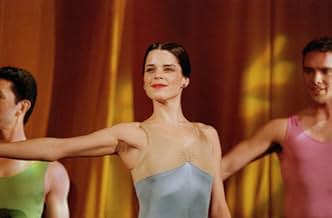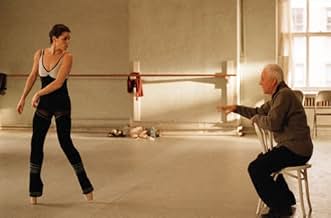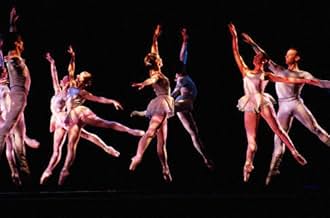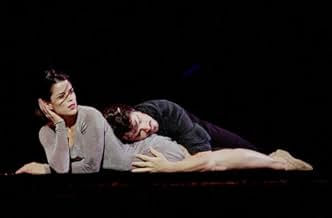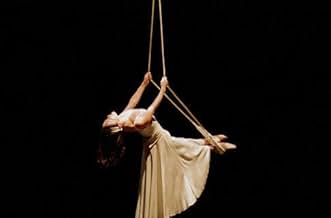NOTE IMDb
6,2/10
7 k
MA NOTE
Ajouter une intrigue dans votre langueA young ballet dancer is poised to become the principal performer in a group of ballet dancers.A young ballet dancer is poised to become the principal performer in a group of ballet dancers.A young ballet dancer is poised to become the principal performer in a group of ballet dancers.
- Réalisation
- Scénario
- Casting principal
- Récompenses
- 2 nominations au total
Barbara E. Robertson
- Harriet
- (as Barbara Robertson)
Davis C. Robertson
- Alec - Joffrey Dancer
- (as Davis Robertson)
Avis à la une
I suppose you can call this splendid movie a documentary showing several months in the life of the Joffrey Ballet of Chicago. However, as there are some dramatized elements (albeit to a minimum), you can't technically call it a documentary. And yet, it's more truthful than many "full" documentaries. Completely free from contamination of melodrama, the movie shows us, in a matter-of-fact manner, things behind the stage dedication and sacrifices, lucky breaks that even the top talents sometimes need, experienced performers arguing anainst new ideas, injury and understudy stepping in at a moment's notice, disappointment from being fired, and much more.
Doing what he does best, master Altman gives you an inconspicuous spot in the rehearsal hall, in the meeting room, back stage, to show you how an idea evolves right from an artist's concept to a successful performance the road that is sometimes painful, sometimes exhilarating and everything in between, the process that affects the lives of the people who are part of the whole. Overlapping dialogue here is not just Altman's artistic and technical trademark, but the way people REALLY speak. Through his amazing deployment of the camera, he also gives the audience a kaleidoscope of events and emotions that are fleeting and fluid, and yet remain with you long after the movie.
In addition to the insight of the documentary, dance lovers will enjoy the generous helping of dance scenes, particularly the outdoor performance in a thunder storm at the beginning. And although personal story is not the point of this movie, the depiction of the relationship between the characters played by Neve Campbell (the dancer) and James Franco (the chef) is wonderful. The scene of their first meeting is a joy to watch she is playing pool by herself and really enjoying it while he, a drink in hand, regards her somewhat stoically at a distance. The two of them are depicted in so many angles, sometimes in the same frame, sometimes separately. This scene is so mesmerizing that you'll forget the passage of time. At long last, they make eye contact and smile. Then, a cut to the next morning in her apartment when they are just waking up, as he offers to cook breakfast for them. An absolutely beautiful sequence.
Campbell and Franco are simply wonderful. The icon of the movie, however, is artistic director of the company Alberto Antonelli , generally known as "Mr A", who comes off larger than life with the flare of Malcolm McDowell, who undoubted is remembered best from "A clockwork orange".
To people who have experienced the joy of stage performance, even in a very modest way of an amateur choir or theatre group, there is the bonus of additional empathy the sometimes not so smooth rehearsals, the panic as the performance approaches and nothing seems to work, the last minute jitters before curtain, the final jubilation when everything miraculously falls into place and the sincere applause of the audience. Such empathy!
Doing what he does best, master Altman gives you an inconspicuous spot in the rehearsal hall, in the meeting room, back stage, to show you how an idea evolves right from an artist's concept to a successful performance the road that is sometimes painful, sometimes exhilarating and everything in between, the process that affects the lives of the people who are part of the whole. Overlapping dialogue here is not just Altman's artistic and technical trademark, but the way people REALLY speak. Through his amazing deployment of the camera, he also gives the audience a kaleidoscope of events and emotions that are fleeting and fluid, and yet remain with you long after the movie.
In addition to the insight of the documentary, dance lovers will enjoy the generous helping of dance scenes, particularly the outdoor performance in a thunder storm at the beginning. And although personal story is not the point of this movie, the depiction of the relationship between the characters played by Neve Campbell (the dancer) and James Franco (the chef) is wonderful. The scene of their first meeting is a joy to watch she is playing pool by herself and really enjoying it while he, a drink in hand, regards her somewhat stoically at a distance. The two of them are depicted in so many angles, sometimes in the same frame, sometimes separately. This scene is so mesmerizing that you'll forget the passage of time. At long last, they make eye contact and smile. Then, a cut to the next morning in her apartment when they are just waking up, as he offers to cook breakfast for them. An absolutely beautiful sequence.
Campbell and Franco are simply wonderful. The icon of the movie, however, is artistic director of the company Alberto Antonelli , generally known as "Mr A", who comes off larger than life with the flare of Malcolm McDowell, who undoubted is remembered best from "A clockwork orange".
To people who have experienced the joy of stage performance, even in a very modest way of an amateur choir or theatre group, there is the bonus of additional empathy the sometimes not so smooth rehearsals, the panic as the performance approaches and nothing seems to work, the last minute jitters before curtain, the final jubilation when everything miraculously falls into place and the sincere applause of the audience. Such empathy!
George, what I think you meant to say was that you are actually a thick-headed mocho-man who has NO appreciation for the arts whatsoever. If you did, you'd understand that the ballet dancing in this movie was beautiful, and entitled a lot of hard work on the dancers' part. I've danced since I was three, and have met many male dancers along the way, and, to inform you, NOT ONE OF THEM WAS GAY! I'm a STRAIGHT female who has dated a male dancer before. Assumptions like that are completely childish. THe acting, dancing, setting, and costumes in this movie were wonderful. If you can't even appreciate fine movie-making, then you are surely at a loss. Even if you would rather be watching sports, which I completely understand, most men would, that's fine: however, it doesn't give you the right to judge an a form of art that you abviously don't understand.
If you're a devoted fan of ballet or modern dance, you'll enjoy "The Company." Neve Campbell is Ry, a young ballerina and the focal point of the movie, which is an almost documentary-like portrayal of a professional ballet company preparing for and delivering spectacular dance performances in Chicago. Campbell is a former professional dancer, so she brings authenticity to her performance. However, despite the casting of Malcolm McDowell as an authoritarian, acid-tongued company director to provide a potential source of dramatic conflict with Campbell's character, there's very little story or dialogue in the whole film. Some of the dialogue is so quiet and natural that you can't really make it out. Directed by the great Robert Altman, "The Company" focuses mostly on dance performances and grueling practices, with a few cliches thrown in (the dancers' struggles to win roles, please the choreographer and make ends meet financially). It all looks very realistic and beautiful, and the drama is only in the dance. There's a sweet, slight love story for Ry and her equally hard-working chef beau, played by James Franco. So enjoy "The Company" on a quiet evening, glass of wine in hand, if you love to watch good dance performances, but not if you want dialogue or plot. Still, kudos to Neve Campbell for getting such a tasteful, lovely, non-commercial movie made.
The DVD extras with some movies make the film seem better than it did just watching it. "The Company" is a good example.
I'd wondered, briefly, why star Neve Campbell also got producer credit. The DVD 'making of' documentary explains that the whole project was her idea; she'd been a dancer long before she took up acting, and wanted to combine the two. She chose Altman to direct, because of his skill at portraying relations and interactions among people in groups.
Altman did a fine job depicting dance, both rehearsals and performances. Campbell showed she can still dance. Malcolm McDowell gave a great performance as the acerbic company director. The Joffrey dancers were brilliant. Altman has created a dazzling cinematic album of what the world of dance is like at the beginning of the 21st century.
But the story arc was weak. This was no accident. In a recent (October 2004) interview, Altman said:
Question: "Why do you think you're drawn to stories about big groups of people sharing the same space? Did it have anything to do with growing up in such a large, close-knit family?"
Robert Altman: "Possibly. I don't know. That's a little too cerebral for me. I'm not much interested in stories anyway. I'm more interested in reactive behavior."
That sums up "The Company" very nicely. The movie is a montage of scenes of "reactive behavior" among realistic characters, and in this it is more like real life than a more structured story would have been.
Of course there is some story structure here, involving the creation of a new dance. This story is engaging, because the outside choreographer is a fey flake, and dance disaster seems foredoomed. But the dancers, being good soldiers, follow his orders diligently. And despite all expectations, at least all of my expectations, their climactic performance is superb.
But this story is not central to the movie. Again like life, it unfolds amidst all sorts of other organizational and interpersonal drama.
And for this reason the movie left me unsatisfied. Part of what I look for in movies, and in books, is a story arc: a beginning, a middle, and an end. I look for this precisely because life is rarely that neat. Many directors deliver this arc (and many more try to, and fail). Robert Altman chose not to try. He is free to do that, and I am free to rate this movie 7/10.
I'd wondered, briefly, why star Neve Campbell also got producer credit. The DVD 'making of' documentary explains that the whole project was her idea; she'd been a dancer long before she took up acting, and wanted to combine the two. She chose Altman to direct, because of his skill at portraying relations and interactions among people in groups.
Altman did a fine job depicting dance, both rehearsals and performances. Campbell showed she can still dance. Malcolm McDowell gave a great performance as the acerbic company director. The Joffrey dancers were brilliant. Altman has created a dazzling cinematic album of what the world of dance is like at the beginning of the 21st century.
But the story arc was weak. This was no accident. In a recent (October 2004) interview, Altman said:
Question: "Why do you think you're drawn to stories about big groups of people sharing the same space? Did it have anything to do with growing up in such a large, close-knit family?"
Robert Altman: "Possibly. I don't know. That's a little too cerebral for me. I'm not much interested in stories anyway. I'm more interested in reactive behavior."
That sums up "The Company" very nicely. The movie is a montage of scenes of "reactive behavior" among realistic characters, and in this it is more like real life than a more structured story would have been.
Of course there is some story structure here, involving the creation of a new dance. This story is engaging, because the outside choreographer is a fey flake, and dance disaster seems foredoomed. But the dancers, being good soldiers, follow his orders diligently. And despite all expectations, at least all of my expectations, their climactic performance is superb.
But this story is not central to the movie. Again like life, it unfolds amidst all sorts of other organizational and interpersonal drama.
And for this reason the movie left me unsatisfied. Part of what I look for in movies, and in books, is a story arc: a beginning, a middle, and an end. I look for this precisely because life is rarely that neat. Many directors deliver this arc (and many more try to, and fail). Robert Altman chose not to try. He is free to do that, and I am free to rate this movie 7/10.
Some of the dances are tiny religious experiences. The film doesn't look nearly as good as some of Altman's others, but there are flashes of awesome beauty: a topless male dancer alone in a room with golden beams of light, and Neve Campbell in her bath. The movie looks at the queeny pretensions of the boys (and their fathers), the dancers' sex lives (who are more '60s than their instructor knows), and the company leader, played by Malcolm McDowell, whose occasional flakiness is caught by one black dancer. I couldn't help but think of McDowell as an Altman self-criticism: an elderly director working with small budgets, prone to artiness, who champions art as being organic, who rounds up a large crew of performers and calls them "babies." The day-in-the-life shapelessness of the movie didn't at all bother me, though one character, who asks to stay in a dancer's apartment, is dropped pretty quickly. And James Franco is in it. 9/10
Le saviez-vous
- AnecdotesNeve Campbell lost thousands of dollars of her own money to ensure that her fellow cast members received their wages.
- GaffesAt about 1:10 while counting during a rehearsal, Harriet skips the 6th count of 8.
- Citations
Alberto Antonelli: Ry, honey, let's scramble some ideas, instead of some asshole who contradicts me.
- Crédits fousAfter the closing credits begin rolling, the dancers continue to take their final bows, and the audience continues to applaud.
Meilleurs choix
Connectez-vous pour évaluer et suivre la liste de favoris afin de recevoir des recommandations personnalisées
- How long is The Company?Alimenté par Alexa
Détails
Box-office
- Budget
- 15 000 000 $US (estimé)
- Montant brut aux États-Unis et au Canada
- 2 283 914 $US
- Week-end de sortie aux États-Unis et au Canada
- 93 776 $US
- 28 déc. 2003
- Montant brut mondial
- 6 415 017 $US
- Durée
- 1h 52min(112 min)
- Couleur
- Mixage
- Rapport de forme
- 2.35 : 1
Contribuer à cette page
Suggérer une modification ou ajouter du contenu manquant








